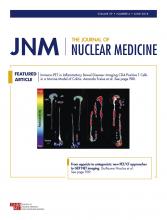PET and NAC in TNBC: Groheux comments on the demonstrated accuracy of change in SUVmax on 18F-FDG PET during neoadjuvant chemotherapy in predicting pathologic complete response in breast cancer and calls for similar trials in patients with triple-negative disease.
Page 863
Diagnostic radiopharmaceutical oversight: Schwarz and Clarke offer perspective on the U.S. evolution of review, assessment, and regulation of new radiopharmaceuticals and preview an article on this topic in this issue of JNM.
Page 865
FDA diagnostic radiopharmaceutical review: Marcus details the way in which the U.S. Food and Drug Administration considers diagnostic radiopharmaceuticals, focusing on common nonradioactive drugs and diagnostic radiopharmaceuticals and calling for formation of a standing advisory committee.
Page 868
PSMA in nonprostate cancers: Salas Fragomeni and colleagues provide a state-of-the-art overview of evidence-based studies and future promise of radiotracers targeting the prostate-specific membrane antigen in a potentially broad range of nonprostate cancers.
Page 871
α-Emitters for radiotherapy: Poty and colleagues, in the first of 2 educational reviews, explore the diversity, basic radiochemistry, restrictions, and hurdles of α-emitting radionuclides in cancer therapeutics.
Page 878
Small proteins for radionuclide imaging: Krasniqi and colleagues focus on small proteins that could allow same-day radionuclide-based imaging, with emphasis on clinical applications and promising preclinical developments in oncology.
Page 885
Machine learning in glioma: Papp and colleagues report on a study designed to establish and validate machine learning–driven survival models for glioma built on in vivo 11C-MET PET data, ex vivo characteristics, and patient data.
Page 892
First-in-human 89Zr-pertuzumab PET/CT: Ulaner and colleagues evaluate the safety, dosimetry, and pharmacokinetics of 89Zr-pertuzumab PET/CT for human epidermal growth factor receptor 2–targeted imaging in patients with HER2-positive breast cancer.
Page 900
From SSR agonists to antagonists: Bodei and Weber survey the development of somatostatin receptor–targeted imaging and therapy for neuroendocrine tumors and preview 2 articles in this issue of JNM on systematic evaluation of PET imaging with radiolabeled sstr2 antagonists.
Page 907
68Ga-OPS202 PET/CT phase I study: Nicolas and colleagues report on evaluation of this novel somatostatin receptor antagonist, including safety, biodistribution, dosimetry, and optimal imaging time-points in patients with gastroenteropancreatic neuroendocrine tumors.
Page 909
68Ga-OPS202 PET/CT phase II study: Nicolas and colleagues present the results of the phase II component of a phase I/II study evaluating the imaging sensitivity of 68Ga-OPS202, compared with that of 68Ga-DOTATOC, in patients with gastroenteropancreatic neuroendocrine tumors.
Page 915
68Ga-RM26 PET in prostate cancer: Zhang and colleagues analyze the safety, biodistribution, and radiation dosimetry of this gastrin-releasing peptide receptor antagonist PET tracer to assess its clinical diagnostic value in prostate cancer patients.
Page 922
PSMA+ total tumor volume and BED: Begum et al. simulate the effect of prostate-specific membrane antigen (PSMA)–positive total tumor volume on biologically effective doses in patients with metastatic castration-resistant prostate cancer undergoing 177Lu-PSMA radioligand therapy.
Page 929
α-RIT in solid tumors: Carlin looks at current challenges to routine clinical use of α-radioimmunotherapy and offers commentary on a recent related article in JNM.
Page 934
Test–retest evaluation of Flortaucipir F 18: Devous and colleagues report on test–retest reproducibility of PET imaging with this tracer for tau neurofibrillary tangles in healthy controls and individuals with mild cognitive impairment and Alzheimer disease.
Page 937
PERSI quantitation of Flortaucipir F 18: Southekal and colleagues present parametric estimation of reference signal intensity, a new technique for Flortaucipir F 18 count normalization that leverages the advantages of white matter reference regions while mitigating potential partial-volume effects.
Page 944
Exploring biomarkers for cocaine addiction: de Laat and colleagues detil findings in a rat model of cocaine self-administration monitored longitudinally using 18F-FPEB PET, proton MR spectroscopy, and behavioral tests.
Page 952
Tau imaging in Alzheimer tauopathy mice: Ni and colleagues use transgenic mouse models of tauopathies to compare in vivo imaging with both 11C-PBB3 PET and MR imaging to postmortem measures of tau probe binding.
Page 960
18F-FDG PET/MR imaging in chronic sciatica: Cipriano and colleagues report on a study assessing the feasibility of an 18F-FDG PET/MR imaging approach to improving diagnosis of chronic sciatica and possibly elucidating causative pathology.
Page 967
11C-Erlotinib PET in the human brain: Verheijen and colleagues describe the effects of the ABCB1 and ABCG2 transporter inhibitor elacridar on brain uptake using 11C-erlotinib PET in mice and in patients with advanced or metastatic solid tumors.
Page 973
Anti-CD4 immuno-PET in colitic mice: Freise and colleagues report on PET imaging with an antimouse CD4 antibody fragment targeting CD4-positive T cells in a mouse model of inflammatory bowel disease.
Page 980
Fluorescent dyes and tracer kinetics: Buckle and colleagues introduce a bimodal hybrid tracer design to systematically and quantitatively evaluate the influence of elongation of the polymethine chain in a fluorescent cyanine dye on the imaging potential of a targeted tracer.
Page 986
Mini-EXPLORER PET scanner: Berg and colleagues describe a long-axial-field-of-view PET scanner for high-sensitivity and total-body imaging of nonhuman primates and present the physical performance with first phantom and animal imaging results.
Page 993
Reproducibility of thoracic MR-AC maps: Olin and colleagues evaluate the quality of current vendor-provided thoracic MR attenuation correction maps and the reproducibility of their impact on 18F-FDG PET quantification in patients with non–small cell lung cancer.
Page 999
New-generation fetal dose estimates: Stabin provides revised radiopharmaceutical dose estimates to the fetus based on RAdiation Dose Assessment Resource International Commission on Radiological Protection 89 reference female pregnant and nonpregnant models.
Page 1005
- © 2018 by the Society of Nuclear Medicine and Molecular Imaging.







